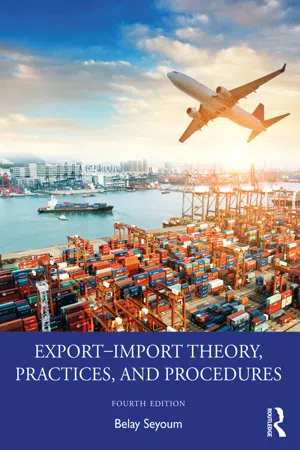
- 656 pages
- English
- ePUB (mobile friendly)
- Available on iOS & Android
Export–Import Theory, Practices, and Procedures
About this book
This book remains the sole export–import textbook aimed squarely at the academic audience. Discussing theoretical issues in depth, while maintaining a practical approach, it offers a comprehensive exploration of import procedures and export regulations.
In addition to updated cases, this new edition includes:
- New major developments in bilateral and regional trade agreements
- Changes to INCOTERMS 2010
- Coverage of the role of e-commerce
- Expanded updates on methods of payment, export pricing, and government export finance
This clearly written and comprehensive textbook will ground students in theory and prepare them for the realities of a career in this fast-moving field. Suitable for upper-level undergraduates and postgraduates of international trade, the book stands alone in its blend of conceptual frameworks and cogent analysis. A related website, filled with export–import resources, opinion pieces, cases, and the latest news is located at: www.export-importtradecenter.com.
Frequently asked questions
- Essential is ideal for learners and professionals who enjoy exploring a wide range of subjects. Access the Essential Library with 800,000+ trusted titles and best-sellers across business, personal growth, and the humanities. Includes unlimited reading time and Standard Read Aloud voice.
- Complete: Perfect for advanced learners and researchers needing full, unrestricted access. Unlock 1.4M+ books across hundreds of subjects, including academic and specialized titles. The Complete Plan also includes advanced features like Premium Read Aloud and Research Assistant.
Please note we cannot support devices running on iOS 13 and Android 7 or earlier. Learn more about using the app.
Information
Part I
Overview of International Trade
CHAPTER 1
Growth and Direction of International Trade
Learning Objectives:
International Trade in Practice
Covid-19 and Its Effects on International Trade
- Seaports such as Rotterdam and Shanghai witnessed a significant drop in container throughput volumes.
- Cargo volumes declined as many countries began to change port protocols ranging from port closure and quarantine measures to additional documentation requirements.
- Lockdowns also impacted the availability of labor to unload ships. It also raised costs due to increased protective equipment for workers. Additional costs were incurred by firms due to the introduction of health and safety measures for participants.
- The additional measures implemented to prevent transmission resulted in higher transaction costs for firms engaged in international trade.
- Maintenance of open supply chains for essentials
- Avoidance of export restrictions that would exacerbate the problem.
- Rejection of protectionist policies that distort trade.
- Pursuance of paperless trade
- Preparation of advance measures to reduce vulnerability to external shocks
- Promotion of regional value chains to take advantage of economies of scale.
| GDP growth | Export (import) growth* | |||||||||||||||
|---|---|---|---|---|---|---|---|---|---|---|---|---|---|---|---|---|
| 2016 | 2017 | 2018 | 2019 | 2016 | 2017 | 2018 | 2019 | |||||||||
| World | 2.59 | 3.26 | 3.04 | 2.48 | 2.68 (2.28) | 5.09 (6.02) | 4.27 (4.19) | 1.46 (1.61) | ||||||||
| North America | 1.51 | 2.31 | 2.84 | 2.27 | 0.28 (1.67) | 3.05 (4.63) | 3.03 (4.08) | 2.92 (1.70) | ||||||||
| USA | 1.57 | 2.22 | 2.93 | 2.33 | -0.01 (1.99) | 3.48 (4.71) | 3.02 (4.37) | -1.1 (-1.7) | ||||||||
| Canada | 1.00 | 3.17 | 2.01 | 1.66 | 1.41 (0.05) | 1.41 (4.24) | 3.08 (2.60) | 1.28 (0.56) | ||||||||
| Latin America & Caribbean | -0.34 | 1.77 | 1.57 | 0.83 | 2.43 (-1.17) | 3.79 (6.31) | 4.09 (5.04) | 0.67 (-0.82) | ||||||||
| European Union | 2.05 | 2.73 | 2.15 | 1.52 | 3.39 (4.38) | 5.72 (5.43) | 3.68 (3.56) | 2.65 (3.78) | ||||||||
| Central Europe & Baltics | 3.05 | 4.79 | 4.42 | 3.69 | 7.00 (6.32) | 7.60 (8.17) | 5.42 (6.86) | 3.93 (3.92) | ||||||||
| Middle East & N. Africa | 4.96 | 1.72 | 2.38 | 1.81 | 5.41 (-3.08) | 2.45 (6.83) | 6.29 (6.10) | 7.2 (5.5) | ||||||||
| East Asia & Pacific | 4.09 | 4.76 | 4.17 | 3.76 | 2.04 (1.47) | 6.41 (6.72) | 4.69 (5.04) | -2.5 (3.5) | ||||||||
| South Asia | 7.78 | 6.83 | 6.10 | 4.83 | 4.35 (4.38) | 4.12 ... | ||||||||||
Table of contents
- Cover
- Half Title
- Title Page
- Copyright Page
- Table of Contents
- Introduction A Brief History of International Trade
- Part I Overview of International Trade
- Part II Export Planning and Strategy
- Part III Executing the Transactions
- Part IV Payment Terms and Procedures
- Part V Financing Techniques and Vehicles
- Part VI Export Regulations and Tax Incentives
- Part VII Import Procedures and Techniques
- Chapter 17 Selecting Import Products and Suppliers
- Chapter 18 The Entry Process for Imports
- Chapter 19 Import Relief to Domestic Industry
- Chapter 20 Intellectual Property Rights
- Appendices
- Index